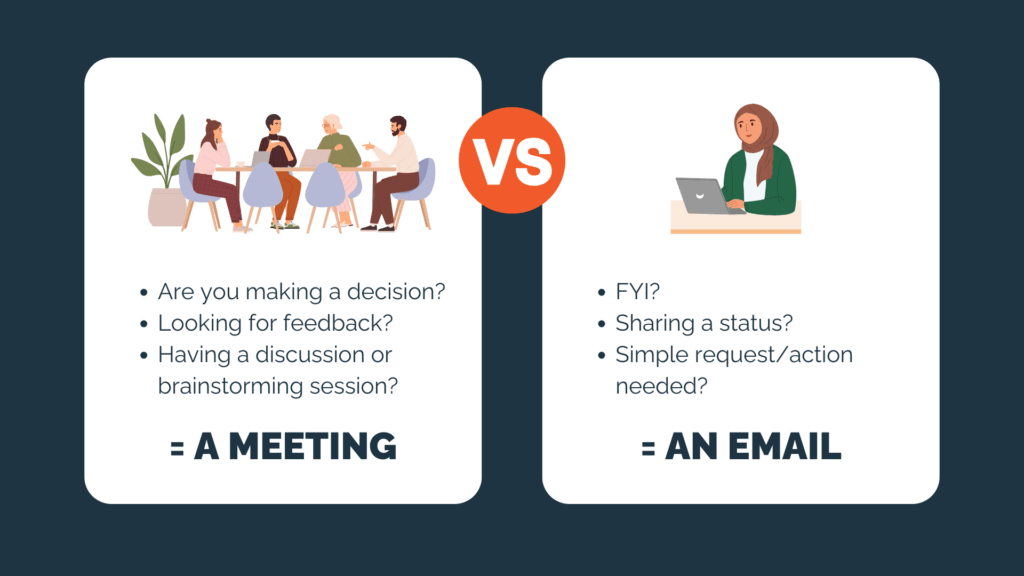Ever find yourself sitting in a meeting thinking, “this could have been an email?” Well, you aren’t alone. Unproductive meetings cost companies $37 billion every year. We are all having too many meetings and many of them aren’t necessary.
But we’re each part of the problem.
Think of how many meetings you’re scheduling every week that impact others’ calendars and bandwidth. If you added up the time spent by each attendee in the meeting, how much is your meeting costing the business?
Now think of all the meetings you find yourself sitting in and wondering why you’re there. How much of your time is spent unnecessarily in meetings? What’s that lost time costing the business?
How do we prevent this wasted time and money?
Define the Purpose of Your Meeting
Before you schedule that next meeting, define exactly what the purpose of the meeting is. What is the intended result or output of the meeting?
Questions to ask before setting your meeting:
- What are you trying to accomplish?
- Is this the most efficient way to accomplish what you’re doing?
- Would an email, poll, or survey potentially be more effective and efficient?
If you answered, “I need these people to know about this topic”, then you probably don’t need a meeting. If it can be summarized in an email or report then send it to the group and highlight some key areas of interest at the top of the email.
If you answered, “I need this group to come to a decision”, then you likely need a meeting—especially if a discussion is needed. Some decisions are best handled via a poll or survey, but lots of business decisions require discussion.
Consider Who You’re Inviting and Communicate Why
Once you’ve decided you need a meeting, make sure your meeting invite clearly states the purpose of the meeting. Also, if you want everyone to attend your meeting, include their role in the meeting invite.
For example: “Alex and Jo – I need your inputs on the engineering timeline. Yu – I need your approval on the staffing plan. Nilesh – I want your inputs on potential risks.”
Not only will they be less likely to miss the meeting, but they’ll come prepared. Additionally, if they can’t make it, they’ll prioritize sending a delegate who can accomplish what you need. By communicating the meeting’s purpose, you’ll be more likely to have a successful meeting that isn’t wasting any time. With everyone competing over time on each other’s calendars, this is how you build trust with your colleagues. When you set a precedence for running impactful meeting, others will have more confidence in you and your meeting requests.
Protect Your Calendar by Asking Questions
Having good meetings that don’t waste time is everyone’s responsibility. This means not blindly accepting every meeting invite that pops up in your inbox.
If you receive a meeting invite without an agenda or clear indication of why you’re required, ask. Do they need your expertise? Or are they just trying to keep you in the loop? By understanding why you’re invited, you can make informed decisions on whether your time is needed.
Common Questions About Unproductive Meetings
What is an unproductive meeting?
An unproductive meeting fails to achieve its goals, lacks a clear agenda, and wastes participants’ time. It often includes off-topic discussions, unprepared participants, unclear action items, and poor time management. Unproductive meetings reduce team efficiency, waste company time and money, and can lower morale when they happen regularly.
Is it rude to decline a meeting?
Declining a meeting is not rude if done respectfully. Professionals often decline meetings to manage time and prioritize tasks. Communicating promptly and politely shows respect for others’ time while maintaining boundaries.
How do you politely decline an unnecessary meeting?
Politely decline an unnecessary meeting by thanking the organizer, stating your reason, and offering an alternative. Say, “Thanks for the invite, but I believe my input isn’t needed. Please share notes afterward.” This approach respects their effort while maintaining your focus and time.
Impactful Meetings Start with You
Creating a workplace culture of impactful meetings starts with you. By taking the time to think through whether an email is the most effective way to accomplish your goals, you’re being responsible with company time and money. By letting all invitees know why they are invited, you ensure that everyone’s on the same page about what needs to be done for a successful meeting. And finally, by getting curious and asking questions about the meetings you’re invited to, you can make sure your time and energy is going where it’s needed.
If your workplace is struggling with it’s meeting culture, professional development initiatives are a great way to improve outcomes. A lot of professionals have never learned how to run an effective meeting and investment in developing that skill set will go a long way. Options like executive coaching, team coaching, leadership courses, and workshops are a great way to develop your talent and drive results.

